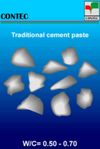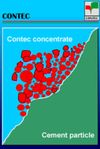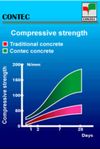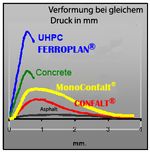Our Technology
Traditional Cement Particles

Due the attractive surface forces between cement particles, the particles are locked in a relatively open structure. A large amount of mixing water is necessary to get a good workability. This high w/c ratio results in a large amount of pores between the cement particles what will give a low strength and an insufficient durability to the hardened matrix. |
Micro structure in the Binder

Ultra fine fillers: micro silica, consists of amorphous silica particles with a average diameter of 0,1 – 0,2 µm and a specific surface of 25.000 m²/kg. Micro silica is super puzzolanic and converts the less useful calcium hydroxide crystals into the useful calcium silicate hydrate. The micro silica particles must be dispersed very well in the matrix to reduce the water/ cement ratio and to get the maximum density from the hardened matrix. |
Compressive Strength

High or very high compressive strengths are possible. The final strength is depending on the type of binder, size, quality and type of the aggregates and type and amount of reinforcement. Compacting under pressure and/or an extra heat treatment will give extreme high compressive strengths.
|
Strength, impermeability and wear resistance

Since the Contec Binder has a very high strength, ordinary aggregates are the weakest components. The The image shows how fracture occurs in the aggregates and not in binder. Significant improvements are achieved by using very strong aggregates. Not only the strength, size and type of the aggregates but also the surface structure is important. |
